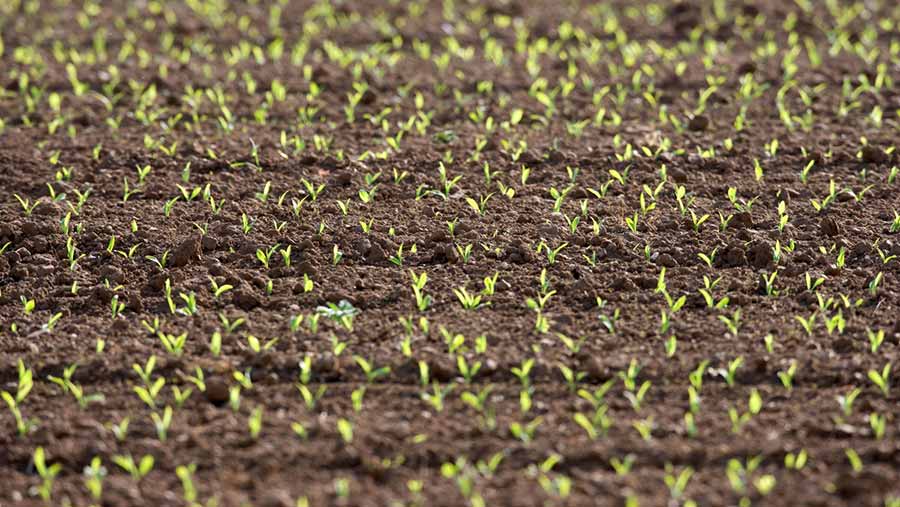Agronomists report maize weed concerns
 © Tim Scrivener
© Tim Scrivener This season has been the time of the aphid, according to AICC agronomist Tod Hunnisett, who highlights widespread barley yellow dwarf virus being seen in cereals
One pest Frontier’s Marcus Mann is concerned about is the diamondback moth from the Continent, which can affect oilseed rape crops. On a more positive note, AICC agronomist David Martindale has never seen so much aphid predation by beneficials.
Maize crops are looking good and Mr Hunnisett says this is the first year for many that maize has come up green and stayed green. However, where a pre-emergence herbicide was not applied, Pearce Seeds’ Giles Simpson advises taking weeds out as soon as possible with a post-emergence spray.
See also: Early signs of chocolate spot found in Lincolnshire spring beans
North: David Martindale
Arable Alliance (Yorkshire)
 Winter wheats are receiving their T3 fungicides. Fusarium is the main target, particularly on milling wheats, which are receiving a higher rate of azole fungicide. However, yellow rust pressure remains high given the cool and humid weather along the east coast.
Winter wheats are receiving their T3 fungicides. Fusarium is the main target, particularly on milling wheats, which are receiving a higher rate of azole fungicide. However, yellow rust pressure remains high given the cool and humid weather along the east coast.
On susceptible varieties, different fungicide mixes have been used to top up the yellow rust control. Any fungicide spray misses from earlier applications show just how devastating this disease can be, as it has destroyed most green leaf area already.
Septoria tritici control has been very good from fungicides used earlier this spring, which is great news considering how high the pressure was.
Winter oats look particularly well and the panicles are just emerging. T2 fungicides will be applied once these have fully emerged to protect against mildew.
Awns are beginning to emerge on earlier-sown spring barley crops, so T2 fungicides are currently being applied that will provide enough protection through to harvest. Plant growth regulators are often not required on spring barley, but some of these earlier-sown crops are so thick and forward that some growth regulation has been required.
Tip of the week
If grassweed levels are low enough to rogue, go and do it. Roguing is one of the best investments you can make in order to help reduce future grassweed burdens. David Martindale, AIC
Spring beans are just beginning to open their first flowers.
Chocolate spot is currently at low levels, but downy mildew is becoming increasingly obvious and is exceeding threshold levels in some cases.
Unfortunately the fungicide for downy mildew is particularly expensive, but this disease could reduce yields significantly if left unchecked.
Aphid numbers are quite high in bean crops, but many have been attacked by predators. I have witnessed the highest level of aphid predation for many years, which is great to see as often the aphid numbers build up faster than the predators.
South: Tod Hunnisett
AICC (Sussex)
 After putting the cereals to bed and just waiting on a few more recommendations for peas, beans and linseed, it is nice to think things will start to calm down a bit before harvest.
After putting the cereals to bed and just waiting on a few more recommendations for peas, beans and linseed, it is nice to think things will start to calm down a bit before harvest.
It gives us the opportunity to look back on what has been another completely abnormal year, which is actually the case every year. A colleague of mine described 2016 as “the year of the aphid”, which certainly rings true when you see the barley yellow dwarf virus in all cereals, including spring barley. It just shows how late it came in.
Peas and beans have their fair share too and repeat applications of aphicides make life quite interesting, given label restrictions on certain products.
So from a very mild, wet winter we went into a very cold, dry(ish) spring. Good from a disease management point of view, but tatty fields of blackgrass and brome bear witness to the fact that conditions at the time of spraying are critical to get the best out of our ever-shrinking armoury of grassweed products.
Most people were sensible enough not to rush in with maize drilling this year and generally, crops look well for it. We have had both moisture and warmth recently and this is the first year for many that maize has come up green and stayed green.
Pre-emergence spray efficacy has varied from fantastic to useless, but at least the conditions for post-emergence follow-ups are better than they were last year.
On to next year. I have a growing number of farms where some radical changes in thinking will have to take place if we want to slow down the losing battle against blackgrass and ryegrass. Does anybody know any good ploughing instructors out there?
East: Marcus Mann
Frontier (Essex)
 Winter wheats are ranging from the early- to mid-flowering stage and T3s are being applied. With the unsettled weather, fusarium and septoria are a concern and prothioconazole will need to be incorporated.
Winter wheats are ranging from the early- to mid-flowering stage and T3s are being applied. With the unsettled weather, fusarium and septoria are a concern and prothioconazole will need to be incorporated.
This year has shown the benefits of varieties with higher rust and septoria resistance scores. Varieties such as Revelation have proven their disease-resistance scoring, both in trials and in the field, and is worth considering in variety choices for next year.
Orange blossom midge were being found, but fortunately most varieties without inherent resistance had begun flowering (GS69) when levels began to rise.
Once at this growth stage, the larvae are unable to penetrate through the hardening seed coat.
This is something to consider when discussing varieties for next year, as without the use of chlorpyrifos, we have very few options for future control. This makes the milling wheat Skyfall particularly useful in a high-pressure year.
Winter oilseed rape is beginning to reach full pod development and pod sealant applications will be considered, spraying separately from the glyphosate.
This timing gives a further prolonged period of protection as it is applied while pods are still green. It also lays down the tramlines, which minimises seed losses when travelling through later for desiccation.
A pest that has raised concerns is the diamondback moth, brought from the Continent on the recent easterly winds. This pest mainly affects brassicae species and will affect oilseed rape, but larvae are also being found in peas. The emerging larvae will cause crop damage, so it is worth keeping an eye on.
Spring peas are flowering and the first fungicide has been applied to protect from botrytis. Pea aphid levels have been particularly high and pea moths are being found in pheromone traps.
West: Giles Simpson
Pearce Seeds (Wiltshire/Dorset/Somerset)
 The recent good weather has allowed sprayers to keep pace with the crops, so all wheats should now have had their T3 fungicide application.
The recent good weather has allowed sprayers to keep pace with the crops, so all wheats should now have had their T3 fungicide application.
It is very noticeable that crops where the timings of fungicide have been correct and dosage has not been cut back are clean and have been given every chance to fulfil their potential.
In contrast, in situations where timings and dosage were compromised disease is present – especially yellow rust – and the sprayers have been back in to cure this.
There is now a lot of grassweeds showing in the winter crops. I think most of this was due to the autumn herbicide applications being late or missed because of poor weather and ground conditions. The exception is hybrid barley, which looks as if it has smothered some weeds.
Pre-emergence herbicide applications on forage maize and fodder beet have done an excellent job and weed levels are low. Most maize has germinated evenly and has been loving the past few weeks of hot and humid weather.
Some seed-beds and drilling have left certain crops struggling and it is so disappointing and frustrating to see seed on or just below the surface not germinated.
Where no pre-emergence spray was applied to maize, the weeds need to be taken out as soon as possible if this hasn’t been done already.
